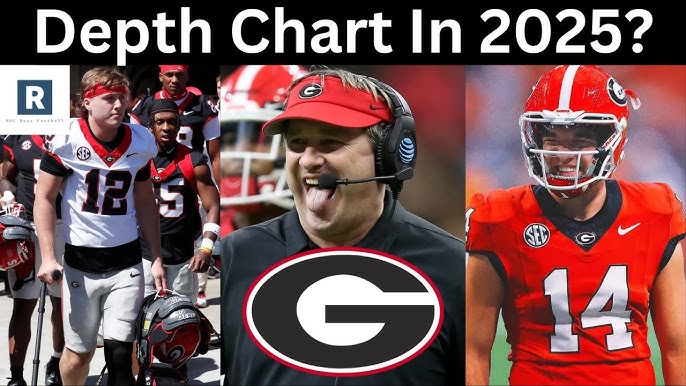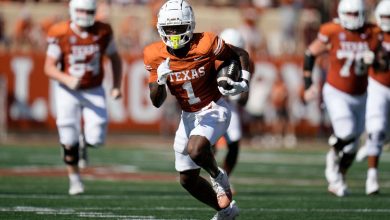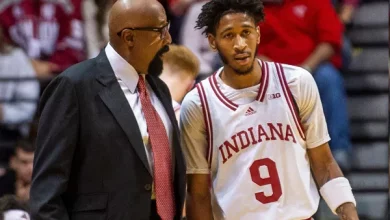The biggest stat Georgia Football needs to change in 2025 is third-down conversion percentage.

Georgia football has dominated college football over the past several years, consistently ranking among the elite programs in the nation. With national championships in 2021 and 2022, head coach Kirby Smart has transformed the Bulldogs into a powerhouse. However, like any top-tier program, there are areas where improvement is necessary for sustained dominance. One of the most critical areas for Georgia to address in 2025 is their third-down conversion percentage.
While Georgia has had tremendous success in many facets of the game — from recruiting to defense to special teams — third-down efficiency has remained a key area that needs improvement. This statistic not only reflects a team’s ability to maintain possession and control the tempo of the game, but it also impacts overall scoring and momentum. A team that struggles on third down often finds itself in disadvantageous situations, whether that means giving the ball back to the opposition or failing to put together long, sustained drives.
In 2024, Georgia’s third-down conversion percentage was decent but not stellar. The Bulldogs were good enough to get by, but in critical moments, their failure to convert could have cost them in tougher matchups, especially when facing elite competition. To maintain their status as a dominant program and make another run at a national championship in 2025, improving third-down conversions must be a priority.
Why Third-Down Efficiency is So Critical
Third downs are a crucial aspect of football, serving as the deciding factor in whether an offense continues its drive or is forced to punt. Third-down efficiency can tell a lot about a team’s offensive consistency, ability to make adjustments, and execution under pressure. For Georgia, this stat has been somewhat underwhelming in recent seasons, with the Bulldogs converting around 40-45% of their third-down attempts in 2024 — a mark that, while decent, leaves plenty of room for improvement.
At its core, third-down conversion is all about execution. It’s about maintaining a manageable distance and having the confidence to move the chains when it counts. Whether it’s converting third-and-short or overcoming third-and-long, the ability to sustain drives is vital to controlling the flow of a game. This not only keeps the opposing offense off the field, but it also wears down defenses and can lead to more scoring opportunities.
When a team is unable to convert on third down, it opens the door for the opposition to take control of the game. Giving the ball back quickly allows the other team’s offense to stay on the field, gain momentum, and potentially score. For a team like Georgia, which prides itself on physicality and depth, improving third-down efficiency will be crucial in maintaining control in high-pressure situations and key games, particularly during SEC play and in the playoff hunt.
Analyzing Georgia’s Third-Down Numbers
To understand where Georgia needs to improve in 2025, let’s break down their third-down performance in 2024.
Third-and-Short Conversions
On third-and-short situations (3 yards or less), Georgia was fairly effective, converting over 70% of the time. This is a solid statistic, largely due to the presence of a powerful offensive line and a reliable running back corps. Georgia’s ability to run the ball with power, particularly in short-yardage situations, has been one of the cornerstones of their offense. However, in some of their biggest games in 2024, Georgia was still unable to consistently convert on critical third-and-short plays when it mattered most, especially in the red zone. This was evident in several tight games against SEC rivals, where their inability to keep drives alive on short yardage situations could have led to more touchdowns rather than field goals.
Third-and-Medium to Long
The area where Georgia’s offense struggled most on third down was in medium-to-long situations (between 4 and 10 yards). In these situations, the Bulldogs converted only about 35% of the time in 2024 — a mark that is below the national average for top-tier programs. While Georgia has a talented quarterback in Carson Beck (or whoever will be at the helm in 2025), the team has not always been able to execute efficiently in these scenarios. This is particularly important as opposing defenses gear up to stop Georgia’s running game, forcing them to rely more on the passing attack in longer third-down situations.
In these scenarios, the Bulldogs faced an array of challenges, including unbalanced offensive play calling, inconsistent pass protection, and a lack of reliable receiving targets to move the chains. While Brock Bowers, one of the best tight ends in college football, has been a reliable target, Georgia’s wide receivers have often lacked the consistency to create separation and make crucial catches when needed.
Additionally, while Beck or other quarterbacks in Georgia’s system are capable of making plays, third-and-long situations have often resulted in forced passes or hurried decisions, leading to either a sack, incompletion, or turnover. This inability to execute in longer third-down situations has prevented Georgia from turning potential field goals into touchdowns, stalling drives at key moments and leaving points on the board.
Why the Third-Down Struggles Matter
In the SEC, where defenses are particularly strong, third-down efficiency can be the difference between winning and losing. When Georgia faces elite teams — especially in games against Alabama, LSU, or in the postseason — the ability to sustain drives on offense becomes even more crucial. A failure to convert on third down can cause momentum to shift in favor of the opposing team, which is particularly dangerous when playing against high-powered offenses.
Further, improving third-down conversion percentage would give Georgia’s defense a much-needed breather. In past seasons, Georgia has often relied on its defense to keep games under control. However, if the offense fails to convert on third downs, it puts additional strain on the defense by keeping them on the field longer. Over the course of a season, this can lead to fatigue, missed tackles, and breakdowns in coverage — all of which can become more pronounced in high-pressure situations.
Impact on Field Position and Time of Possession
One often-overlooked consequence of failing to convert on third down is the impact it has on field position and time of possession. Teams that cannot sustain drives are forced to punt more often, giving the opponent better field position. This becomes particularly damaging when facing teams with explosive offenses that can score quickly. Conversely, teams that are able to convert third downs successfully are able to control the game’s tempo, grind down the clock, and wear out opposing defenses.
In games where field position is critical, being able to sustain drives through effective third-down conversions gives Georgia an edge in controlling both the clock and the momentum of the game. Additionally, improving this statistic would likely translate into more red zone opportunities, where finishing drives with touchdowns is paramount to success.
What Needs to Change in 2025
In order to improve third-down conversion percentage, Georgia must make several key adjustments across their offense:
- Improved Passing Attack on Third-and-Long: Georgia must become more effective in longer third-down situations. This starts with improving pass protection, allowing the quarterback to survey the field and make the best decision. The Bulldogs need to create more separation among their wide receivers to give the quarterback more options and help move the chains. A more balanced offensive attack, where the passing game is more consistent, will make it harder for defenses to predict what’s coming.
- Better Play Calling: Play calling on third downs must be more creative and strategic. In third-and-medium or third-and-long situations, Georgia’s offensive coordinator must be able to adapt to the defense’s alignment and exploit weaknesses. Additionally, incorporating more misdirection, play-action, and screen passes could catch defenders off guard and open up lanes for the offense to convert.
- Growth from the Quarterback Position: Whether Carson Beck or another quarterback takes the reins, the signal caller must be able to read the defense effectively and make quick decisions. In third-and-long situations, quick releases and smart ball placement are essential. The quarterback must avoid forcing throws and instead focus on taking what the defense gives them, even if it means dumping the ball off to a running back or tight end.
- Developing a Deeper Receiving Corps: While Georgia has had elite talent in the past with players like Brock Bowers, they need more reliable weapons at wide receiver. Building depth at this position will give the quarterback more reliable options, especially in crucial third-down situations.









